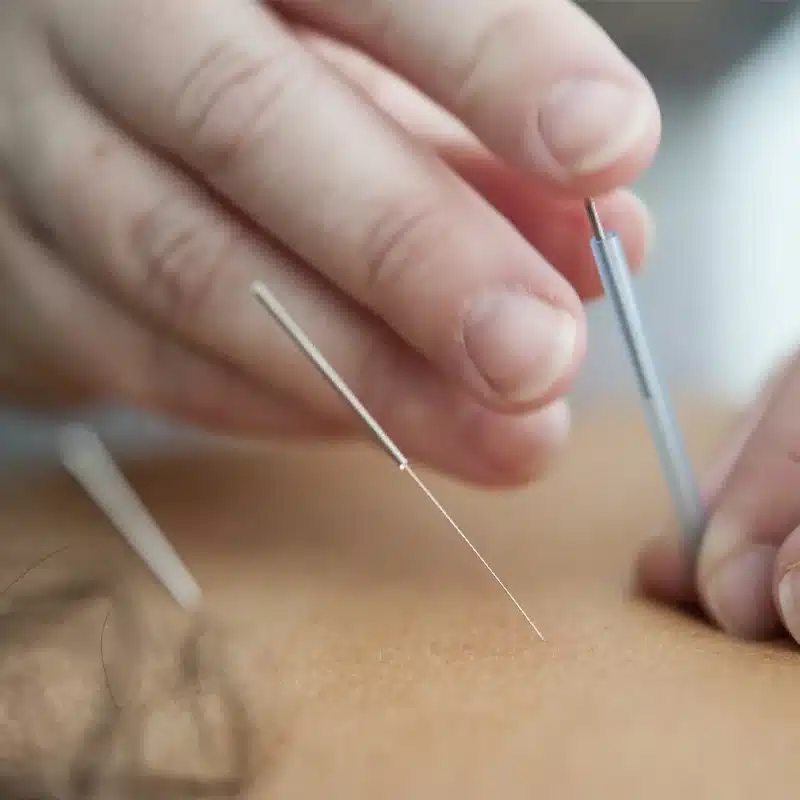Dry Needling Treatment
Benefits of Dry Needling
Precise Pain Relief
Dry Needling specifically targets muscle knots or trigger points that cause pain. This technique offers immediate relief by resolving muscle tension and facilitating muscle relaxation.
Improved Muscle Recovery
Effective for athletes and active individuals, Dry Needling accelerates recovery by improving blood flow to affected muscles, reducing inflammation, and alleviating muscle discomfort.
Improved Mobility
By relieving muscle tightness and reducing strain on joints, Dry Needling enhances overall mobility and flexibility, making daily activities and movements more comfortable and pain-free.
What is Dry Needling?
Dry Needling involves inserting thin needles into muscle tissue to treat pain and muscle dysfunction. It is a scientifically supported method especially effective for treating chronic pain and improving muscle function by directly stimulating the muscles. This technique focuses on identifying and treating trigger points in the muscle, which can effectively relieve pain and improve mobility. By activating these points, the body’s own healing processes are promoted, which can lead to faster recovery and reduced pain. The treatment is performed by certified therapists and is often combined with other forms of therapy for the best results. Dry Needling is also known for providing immediate relief and is therefore often used as part of a larger rehabilitation plan for muscle injuries and chronic conditions.


The Process for Dry Needling
During a session, a qualified therapist uses sterile disposable needles to puncture and stimulate the muscles. This promotes a faster healing process and reduces pain by directly affecting the muscle condition. The therapist first identifies the specific muscles involved and then uses carefully selected points to insert the needles. Each needle is inserted into a specific trigger point to maximize the effect on muscle tension and pain. The treatment is very targeted and can be customized to each individual’s specific needs and conditions. This methodology also allows muscles that are inaccessible or deep-lying to be effectively treated. After insertion, the needles can be manipulated to further increase blood flow and stimulate healing processes within the affected area.
Scientific Basis for Dry Needling
Dry Needling is based on extensive research that shows how targeted needle treatment can deeply affect muscles, reduce pain signals, and increase blood circulation, which is crucial for tissue repair and pain relief. Studies in the field have documented that when needles stimulate muscles, natural pain-relieving chemicals such as endorphins and serotonin are released, contributing to faster pain relief and well-being. This mechanism helps to normalize nerve signals and reduce overactivity in the nervous system, which is often associated with chronic pain. The method has also proven effective in increasing mobility and improving muscle function by dissolving trigger points and reducing muscle tensions. The research supports that Dry Needling can be an important part of treating various musculoskeletal problems, from sports-related injuries to chronic pain conditions. These insights provide a strong scientific basis for the use of Dry Needling as a therapeutic intervention.


Dry Needling Compared to Acupuncture
Although Dry Needling uses similar tools as acupuncture, the techniques and applications differ. Dry Needling strictly focuses on neuromuscular issues and muscle relaxation, while acupuncture has a broader application within traditional Chinese medicine. Dry Needling aims to treat specific muscle-related problems by puncturing trigger points to relieve pain and improve muscle function. It is a relatively new technique based on modern scientific understanding of musculoskeletal and neuromuscular systems.
Although both methods use needles, their philosophical and theoretical bases differ significantly. Dry Needling is strictly evidence-based and focuses on the physical aspects of pain relief and muscle recovery, while acupuncture offers a more holistic approach that includes both physical and mental aspects of health.
What can you expect from a treatment?
Many patients experience immediate relief after just one session of Dry Needling, but several treatments may be required to achieve full effect. Some tenderness after the session is common, which is a normal sign that the healing process has begun.
During the treatment, you may feel brief pain or pressure when the needle hits the trigger points. This sensation varies depending on the person and the treated area. Afterwards, some may feel relaxed or tired, which is the result of muscle relaxation and natural pain relief.
It is recommended to drink plenty of water and perform light stretching exercises after the treatment to assist with circulation and reduce soreness. These measures can enhance your recovery and reduce any discomfort.


Scientific Studies and Evidence for Dry Needling
Dry Needling is well supported by scientific research and has proven effective for a variety of conditions. A study from 2019 confirms that the method is effective and safe for treating chronic tension headaches, compared to placebo. In 2017, it was shown that Dry Needling surpasses traditional physiotherapy in terms of effectiveness for relieving chronic lower back pain. Further research has shown that the technique can effectively reduce pain caused byCertainly! Here’s a translation into English of the comprehensive text you provided, including a smooth transition from Swedish to English while maintaining grammatical accuracy and native-like fluency:
Book Dry Needling in Stockholm
